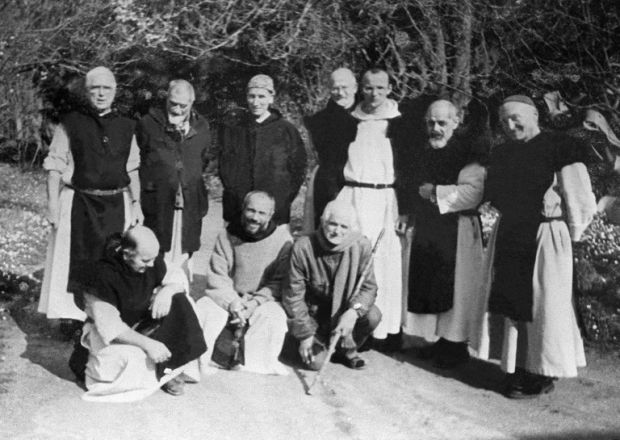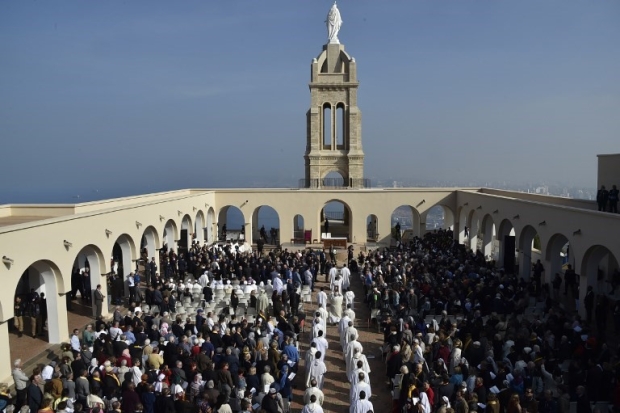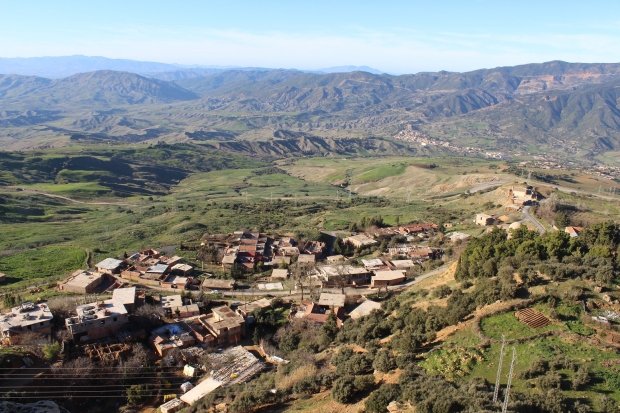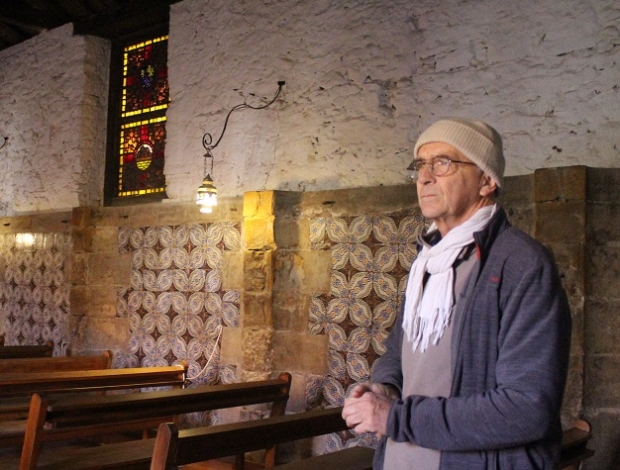Algeria's Trappist monks still spreading message of peace even after death

TIBHIRINE, Algeria - The abbey of Our Lady of Atlas sits on the slope of a hill, overlooking the small village of Tibhirine and a green undulating landscape that is dotted with shrubs and chestnut trees.
The rambling old cloister, built with ancient stones, is bordered by high walls and deeply rooted pine trees. This quiet and bucolic atmosphere is a major draw both for day visitors and for people who stay overnight at the abbey’s guesthouse.
Over the past two years, an increasing number of visitors, mostly Muslims, has come to the monastery, made infamous by the assassination of seven Trappist monks in 1996 during the country’s gruesome civil war that killed some 200,000 people.
He treated my mother. Until now, Brother Luc is a highly respected man in the region
- Mohammed, visitor to Tibhirine
Every day, dozens of Algerians, as families or groups of friends, and some foreigners, visit the abbey, whose story they more or less know. “Most of the visitors come from Algiers, the region of Medea, and Tizi Ouzou but we have met with people from all around Algeria,” said Brother Bruno, who serves as a guide.
Curious Minds
The tour of the monastery, which was founded in 1938 in the region of Medea, a two-hour drive from Algiers, always begins with the modestly ornate chapel. Questions from visitors come in all forms: Is the prayer said in Latin? Are men and women separated in the church? Do the bells still chime? Brother Bruno, a fiftysomething French priest with salt-and-pepper hair, tries to answer in Arabic.
Tourists, who come to the monastery of Tibhirine, have different expectations. “Some know a little about Christianism, but most have never set foot in a church. They are eager to know more about our religion. Others are more interested in the history of the abbey and the lives of the monks that were killed.
"We have received many people who were in contact with them [when they were alive],” Brother Bruno added.
Standing in front of seven marble stones bearing only the first names of the dead monks, Mohammed, accompanied by his four daughters, recalled Brother Luc, who single-handedly ran the monastery’s medical clinic, until his murder.
Painful memories
“He treated my mother. Until now, Brother Luc is a highly respected man in the region,” said the retired teacher, who resides in Medea.
Being here makes me relive the traumatic events we went through
- Mohammed, retired teacher
In the monastery’s cemetery, where the monks’ skulls were buried in the shade of pine trees, Mohammed’s painful memories resurfaced. “Being here makes me relive the traumatic events we went through. I lost many relatives and I was personally threatened to death by Islamist terrorists,” he added.
On 8 December, in Oran, the Catholic Church beatified seven French monks and 12 other Catholics killed during the country's civil war, the first ceremony of its kind in a Muslim nation. Prior to the event, the memory of 114 imams murdered during the civil war was honoured at Oran's Ibn Badis Mosque in the presence of members of the clergy and relatives of the dead monks.
The beatification took place at the Chapel of Our Lady of Santa Cruz in front of Catholic pilgrims and clergy, the Sufi community, and Algerian politicians.
Recently, the monastery has emerged as a symbol of the country’s decades-long tragedy.
“In Algeria, the narrative of the war of independence is hegemonic whereas the civil war remains taboo to discuss even twenty years after it erupted. The monastery is one of the rare places that can be used as a memorial site of the Black Decade,” said Athmane, a French language teacher visiting from Bejaia, who is carrying out a second visit to the abbey.
Brother Bruno, who converted to Catholicism when he turned 30, agreed: “At the cemetery, I often hear visitors telling their own sad stories, and praying for their losses."
Devoted lives
Before the tragic incident, the Cistercian monastery was little known. Nine French monks were among the few Europeans who decided to stay after Algeria gained its independence from France in 1962. Abiding by the rule of Saint Benedict, they devoted their lives to silence, prayers and worship.
They bonded with their Muslim neighbours by teaching French, providing employment at the monastery’s farm, and delivering babies. “Brother Luc had treated up to 800,000 Algerians over 50 years. Alongside [medical] prescription, he also provided poor families with hand-me-down clothes and shoes,” said Brother Eugene, who is in charge of the renovation of the abbey.
Brother Luc had treated up to 800,000 Algerians over 50 years
- Brother Eugene
Feeding the sheep, Samir, who has worked as a farmer in the monastery for the past two decades, has a pleasant memory of that period. “Our relations were excellent. We did not regard them as different than any inhabitant of the village,” said Samir, who considered the abbey his “second house”.
Safe no more
In the 1990s, the north African country was gripped by a protracted conflict between the government and armed groups of Islamist militants. As the war descended into increasing savagery, with daily beheadings, throat-slashings and large-scale massacres, it was no longer safe for the Christian community to reside in the remote mountain region of Medea.
“They chose to put their lives at risk out of solidarity with the local Muslims, who had nowhere to flee. This was an extraordinary act of love for God and the people of Algeria,” said Ibtissem, a student of journalism, while reading the testament of Brother Christian, pinned on a wall in the visitors’ centre. It was written two years before the slaughter.
Nearby, Hafid, who was leaving a message on the guestbook, was impressed by the “monks’ sacrifice” as well. “They are just like any Algerian who died during the civil war: innocent victims,” he said.
More than 20 years after their deaths, it cannot be said for sure who was behind the massacre even though the Armed Islamic Group (GIA), one of the most active militant movements during the civil war, claimed responsibility for the attack.
The heads of the monks were exhumed in October 2014 to conduct a post-mortem examination. The result of a French police investigation was published last February. According to the 280-page report, the monks were beheaded after their deaths and were killed several weeks before their heads were found in Medea. However, the report does not say who was behind their murder.
Algeria has still not managed to break through this wall of silence. Maybe we will never know the truth about their deaths, like thousands of Algerian families who have lost relatives
- Brother Eugene
“Algeria has still not managed to break through this wall of silence. Maybe we will never know the truth about their deaths, like thousands of Algerian families who have lost relatives," Brother Eugene said. "Yet we wish we could discover how they spent their last days, what their relations with their gaolers were,
The aftermath
In the aftermath of the monks’ assassinations, the monastery was not abandoned. A group of monks sought to move to the abbey in 1998, but in the war-torn country, they were not allowed to spend nights in the cloister. After their departure in 2001, Brother Jean-Marie, a French priest, took over and kept the monastery afloat for 15 years.
Life really returned to the monastery when the French Chemin Neuf Community, a Roman Catholic community originally from Lyon, France, was handed control of the site in 2016.
Today, a tiny group, composed of three men and one woman, takes care of the abbey complex that includes a church, a refectory, living quarters, a sheepfold, a henhouse, a small-scale dairy, large terraced vegetable and fruit gardens, and a workshop where they produce organic jam and apple cider vinegar.
Prayer and work
Their communal life is tightly structured according to a special rhythm of prayer, spiritual readings, physical labour, and visits. “The monks’ motto was: ‘pray and work’ as a means of promoting a healthy mind and body,” said Felicite, with her rugged hands folded delicately in her lap.
Brother Christian, who spent as much time with a Bible as with a Quran, left as his legacy a message of peace
- Brother Eugene
The agronomist’s life, likewise her fellows, has been peripatetic since she joined the community in 1997, oscillating between France, Spain, and various African countries. Over the past year, she has spent her days tending to bees, and pruning and cleaning up the 1,300 trees planted in the Tibhirine monastery’s garden.
“In everything we do here, we try to respect the environment by reducing and reusing waste, and growing pesticide-free fruits and vegetables,” Felicite said. “This year, we have produced up to 9,000 jars of jam, which were sold at the monastery’s visitor centre. Most of our vegetable crop is sold fresh in Algiers, at a farmers’ market run by Torba, an Algerian eco-friendly association,” she added.
Interfaith dialogue is another pillar of their communal life. The Chemin Neuf Community wants to turn the monastery of Tibhirine into a model for interfaith bridge-building in Algeria and beyond.
“Here, Catholics are a drop in the bucket. Brother Christian, who spent as much time with a Bible as with a Quran, left as his legacy a message of peace. We must water the seeds bequeathed by the monks. Our duty is to spread their message,” Brother Eugene said.
According to the current monastery’s tenants, the recent beatification of the monks is a positive sign for the future of interfaith relations in Algeria.
Brother Eugene is optimistic: “This celebration shows that we can revisit Algeria’s civil war and stand against the remaining terrorist groups, who exacerbate tensions between the religions throughout the world.”
New MEE newsletter: Jerusalem Dispatch
Sign up to get the latest insights and analysis on Israel-Palestine, alongside Turkey Unpacked and other MEE newsletters
Middle East Eye delivers independent and unrivalled coverage and analysis of the Middle East, North Africa and beyond. To learn more about republishing this content and the associated fees, please fill out this form. More about MEE can be found here.








